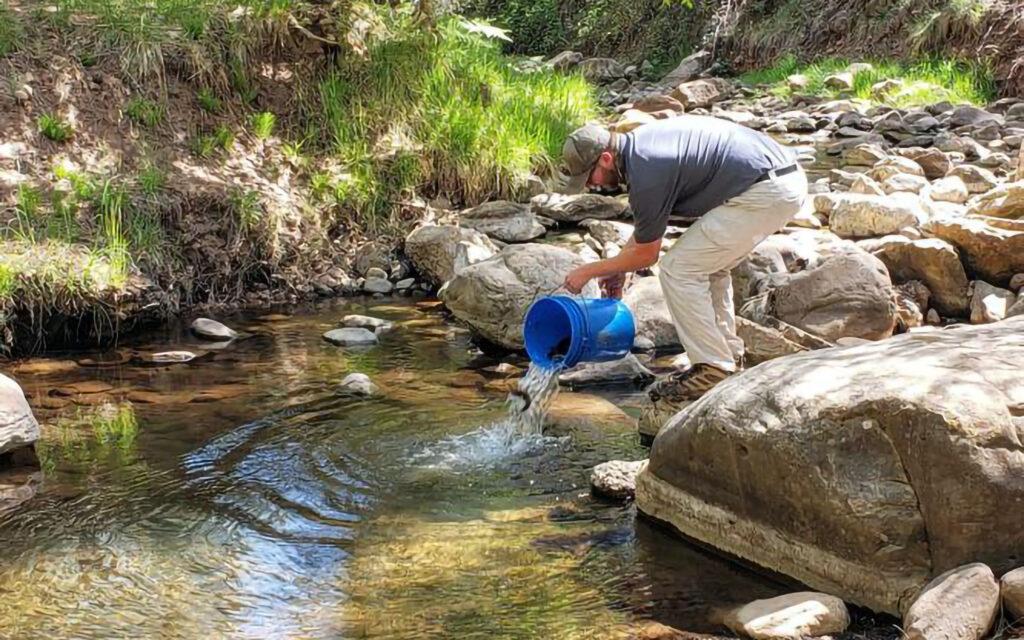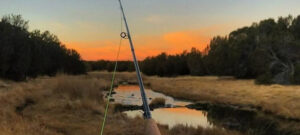Arizona Game and Fish Department hatchery personnel work hard every day responding to the needs of their fish, while striving to raise the healthiest and biggest fish possible for anglers to enjoy catching.
I have had the pleasure over the years to see the operations first hand at both Tonto Creek and Canyon Creek hatcheries. They deal with risks of predators to their fish at night, and drive countless miles to deliver fish to lakes and streams across the state. They carry buckets of fish to pools, sometimes long distances from the truck, to help the fish find their way to great water in the streams. This is done with a tremendous amount of dedication and love for their fish to benefit Arizona anglers.
The Gila trout propagation program at Canyon Creek Hatchery (CCH) is something that many anglers have become very excited about. Catching a Gila trout, which is one of only two native trout to Arizona, is a special treat. The program’s purpose is to raise Gila trout for stocking in Arizona waters, many in Rim Country, for recreational fishing. These trout are from Gila trout eggs produced from broodstock adults raised on-site at CCH.
Initially, the eggs came to Arizona from Mora National Fish Hatchery in New Mexico as part of the effort to restore recovery populations of Gila trout in streams within watersheds where this threatened species was once found historically. When there is a surplus of eggs produced beyond the needs of the recovery program for that year, Mora offers them to Arizona and New Mexico to be used for recreational fishing programs in their historic ranges in both states.
AZGFD decided that the most effective way to use these eggs was to develop a program where the department could create its own supply of trout to be used for recreational fishing rather than depend on surplus eggs from the Gila recovery program at Mora. This program provides great sport fishing, and also allows the department an opportunity to educate anglers about the beauty and importance of this native trout species and the extensive efforts being done by AZGFD to bring these trout back to some of their native habitat through their recovery program.
While these wild recovery populations of trout may be open to catch and release fishing outside of their spawning window, when their population numbers allow and regulations permit, the recreational stockings of Gilas provided by the CCH program in non-recovery waters are much more accessible to anglers.
As a result of the hugely successful spawn last spring of eggs produced from broodstock raised on-site from eggs at CCH, Gila trout recreational stocking from spring 2023 and beyond, will be the result of this propagation program at Canyon Creek Hatchery. That very first batch of eggs from broodstock raised on-site at CCH resulted in approximately 26,000 young trout produced from 120 three-year-old broodstock females.
Raising Gila trout is a more unique process than raising rainbow trout, and required the CCH staff to master a steep learning curve, which they did quickly and with amazing skill. Since rainbow trout have been raised in hatcheries for over a century, these trout have become increasingly tolerant of close human contact and hatchery production operations. In fact, they react to human presence in the hatchery as a signal that they may be fed. That is not the case with Gila trout. Human contact, movement around the tanks, which the Gilas perceive as a predatory threat, and even the normal light that is characteristic of most hatcheries cause stress to Gila trout even as fry and fingerlings. They stop feeding for hours at a time as they seek cover, which therefore slows their growth down considerably. CCH uses circular tanks that provide the fish with an environment where they are always swimming, yet in a darker space that minimizes encounters with the staff. Automatic feeders reduce human contact, and the tanks are cleaned of waste by plugs at the center of the circular tanks that staff can release the discharge unseen by the trout and not frighten them. They have added natural lighting and provide shade covers as needed to help the fish feed more regularly.
That might seem like a lot of extra work, which it is. However, from an angling perspective, it is well worth it, as these trout act like wild trout through all of their life stages and are extremely well-adjusted to life in streams when they are stocked. The CCH staff produced tremendous results from their first year, and continues to enhance their approaches to increase their yield.
During this second year of egg production from broodstock raised on-site, the task was negatively impacted by the 10-degree colder water temperatures this year in the spring that provides the water for Canyon Creek Hatchery. That temperature difference delayed the spawn by about a month, and reduced the number of females that developed enough to spawn.
I recently observed one workday during the Gila trout spawning season. The process is a lot of work for staff, but also is a chance to have some fun doing a job with trout that is unique in Arizona to Canyon Creek Hatchery and this program. In addition to the CCH staff, folks from Tonto Creek Hatchery and Page Springs Hatchery were there to help and actually spawn trout eggs rather than receive them by FedEx as they do now at their hatcheries.
The work required a carefully choreographed process of nine people. It included: netting the adult males and females, briefly anesthetizing them, checking them for ripeness, releasing trout that were not quite ready so that they would revive quickly in fresh water, selecting trout ready to spawn, massaging the eggs and milt out of these adults, gently mixing the fragile eggs and milt with a feather to fertilize the eggs, and releasing the spawned fish for recovery and hopeful use next year. There was also an ongoing assessment of the quality of the eggs, a check for any health risks to the fish during the process, and sampling to be sent off to the AZGFD lab.
The work doesn’t stop there, the approximate 10,000 fertilized eggs produced that day were given a disinfecting iodine solution bath and then secured in incubating trays where they receive a continual supply of clean, well oxygenated water as the very fragile eggs spend the next three to four weeks in an environment that simulates the gravel beds where they would naturally be deposited in streams.
Once the eggs reach the eyed stage, they are firmer and are transferred to upwelling jars where the eggs are gently tumbled to provide continued oxygen to the eggs for about a week while they develop into sac-fry. The sac-fry are the young trout that are largely immobile and dependent on the sac attached to their body for nourishment for about two weeks. They are transferred again to tanks, where they swim freely and feed on their own. Constant care at the hatchery continues for another two years when they are ready to be stocked.
This spring, CCH had 4-year-old fish in addition to their batch of 3-year-old broodstock ready for production. The advantage to 4-year-old fish over 3-year-old fish is that they have grown quite a bit in a year, with some exceeding six pounds, so that their eggs are even larger and more likely to produce even stronger young trout.
This year’s production of eggs again will more than surpass their annual production goals, which bodes well for Arizona waters in Rim Country, and even Upper Oak Creek in Sedona.
I look forward to catching Gila trout from that first batch raised entirely at Canyon Creek Hatchery in the spring of 2023, and truly appreciate the planning, dedication, and hard work to make this dream a reality for Arizona anglers for years to come.
Click HERE to read the full article by Jim Strogen at PaysonRoundup.com.




